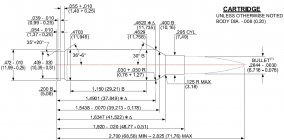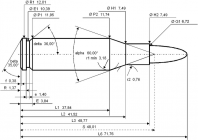I'm still new to hand-loading but I'm trying to get things right...
When I measure the body length for my 6.5CM the slight curve at the transition between the body and the shoulder means that measuring the body length can vary by up to 40 thou depending on where exactly your datum is along that tiny radius. I'm trying to figure out which datum point is the correct one to use.
The three choices seem to be:
1. The beginning of the curve, where the body starts to bend inwards.
2. The end of the curve, where the shoulder flattens
3. The mid-way point between the two, where the angle of the body and the angle of the shoulder would meet
An example with an un-fired Hornady 140gr ELD Match round:
1. 1.4716in / 37.38mm
2. 1.4956in / 37.99mm
3. 1.4836in / 37.69mm (calculated average)
I'm guessing that the correct answer should really be the third option, the mid-way point where the two angles would meet, but I'm not sure.
And the same question also applies to the shoulder <> neck interface too
Thanks!
When I measure the body length for my 6.5CM the slight curve at the transition between the body and the shoulder means that measuring the body length can vary by up to 40 thou depending on where exactly your datum is along that tiny radius. I'm trying to figure out which datum point is the correct one to use.
The three choices seem to be:
1. The beginning of the curve, where the body starts to bend inwards.
2. The end of the curve, where the shoulder flattens
3. The mid-way point between the two, where the angle of the body and the angle of the shoulder would meet
An example with an un-fired Hornady 140gr ELD Match round:
1. 1.4716in / 37.38mm
2. 1.4956in / 37.99mm
3. 1.4836in / 37.69mm (calculated average)
I'm guessing that the correct answer should really be the third option, the mid-way point where the two angles would meet, but I'm not sure.
And the same question also applies to the shoulder <> neck interface too
Thanks!












